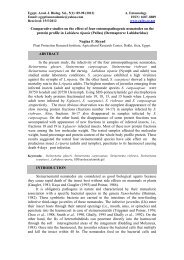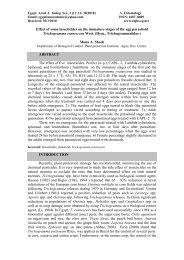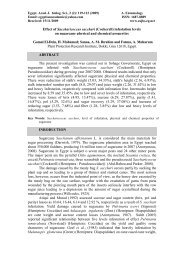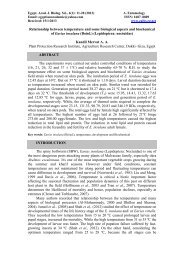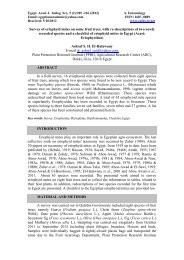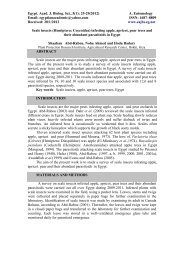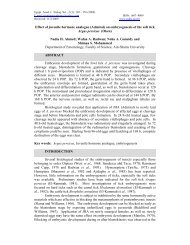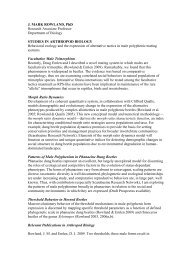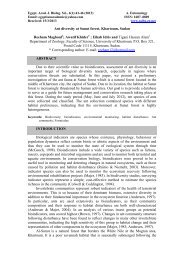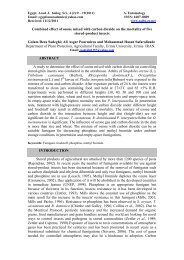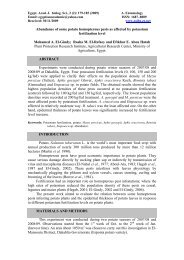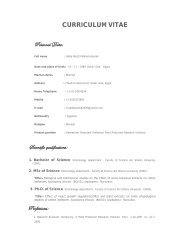Heat Requirements for the Development of the Black cutworm ...
Heat Requirements for the Development of the Black cutworm ...
Heat Requirements for the Development of the Black cutworm ...
Create successful ePaper yourself
Turn your PDF publications into a flip-book with our unique Google optimized e-Paper software.
118<br />
Hassan F. Dahi et al.<br />
MATERIALS AND METHODS<br />
A good number <strong>of</strong> A. ipsilon, larvae were collected from wild host plants at<br />
Dakahlya Governorate. The larvae were reared on caster oil leaves under laboratory<br />
condition (27 ± 1 °C) <strong>for</strong> at least four generations be<strong>for</strong>e experimentation.<br />
Each <strong>of</strong> A. ipsilon stages was kept under three constant temperatures (20, 25<br />
and 30°C ± 1°C) to determine its rate <strong>of</strong> development. Eggs were transferred to<br />
glass vials (2.0 X 7.5 cm); four replicates <strong>of</strong> 25 eggs each were used <strong>for</strong> each <strong>of</strong> <strong>the</strong><br />
temperature to be tested.<br />
Observations were made daily to record <strong>the</strong> time <strong>of</strong> hatchability. The<br />
incubation period and <strong>the</strong> embryo developmental rates were estimated. Newly<br />
hatched larvae were confined in a separate glass tube (7.5 X 2.5 cm) with adequate<br />
castor oil leaves (Ricinus commnuis) <strong>for</strong> feeding. Sawdust was placed at <strong>the</strong> bottom<br />
<strong>of</strong> <strong>the</strong> tubes and <strong>the</strong> top was covered with muslin cloth, secured with rubber band<br />
and maintained in <strong>the</strong> incubators running at 20, 25 and 30 °C. The pupae were kept<br />
in similar tubes, and under <strong>the</strong> same conditions, till moth emergence. After being<br />
sexed, <strong>the</strong> newly emerged moths at each temperature were isolated in pairs, each in<br />
a separate The pairs <strong>of</strong> newly emerged <strong>of</strong> moths were confined in glass oviposition<br />
cages, which consisted <strong>of</strong> a conventional mating glass bells (16 cm. high and 8 cm.<br />
diam.)opened at each end. Each cage had suspended piece <strong>of</strong> cotton wool<br />
previously soaked in 10 % sugar solution. This solution was renewed after 48 hours<br />
<strong>for</strong> moths feeding. The cages were provided with strips <strong>of</strong> muslin, suspended on its<br />
wide end as a suitable site <strong>for</strong> oviposition.<br />
Daily observations <strong>for</strong> each treatment were made to record <strong>the</strong> different<br />
durations <strong>of</strong> <strong>the</strong> embryo, larvae, pupae, pre-oviposition period as well as generation<br />
<strong>of</strong> A. ipsilon under experiment conditions.<br />
The rates <strong>of</strong> development <strong>for</strong> A. ipsilon stages (incubation period, larval<br />
duration, pupal duration, pre-oviposition period and generation) were determined<br />
by <strong>the</strong> simple <strong>for</strong>mula (1/t x 100) <strong>for</strong> three constant temperatures.<br />
Data obtained in <strong>the</strong> present work were subjected to statistical analysis by<br />
regression. The <strong>the</strong>oretical development thresholds were determined according to<br />
<strong>the</strong> following:<br />
Y = a + bx<br />
t0 = -a / b & K = 1 / b<br />
Where: (a): Constant term; (b): Regression coefficient; (r): Correlation coefficient;<br />
(t0): lower threshold <strong>of</strong> development and (K): <strong>the</strong>rmal units (degree-days).<br />
On <strong>the</strong> o<strong>the</strong>r hand, <strong>the</strong>rmal units required <strong>for</strong> completion <strong>of</strong> development<br />
<strong>of</strong> each stage were determined according to <strong>the</strong> equation <strong>of</strong> <strong>the</strong>rmal summation<br />
(Blunk, 1923):<br />
K = y (T - t0)<br />
Where y = developmental duration <strong>of</strong> a given stage; T= temperature in degree<br />
centigrade; t0 = lower threshold <strong>of</strong> development and K = <strong>the</strong>rmal units (degree -<br />
days).<br />
RESULTS AND DISCUSSION<br />
Egg stag:<br />
Data in Table (1) show <strong>the</strong> relationship between A .ipsilon incubation<br />
period and constant temperatures <strong>of</strong> 20, 25 and 30C. This relationship indicated<br />
that <strong>the</strong> required time <strong>for</strong> completion <strong>of</strong> egg development decreased as <strong>the</strong>



